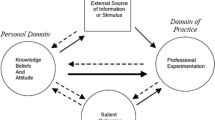Abstract
While classroom teachers are continuously trying to improve their instruction to increase student learning and engagement, dissatisfaction with professional development initiatives are often reported. Researchers examined the extant professional development literature and utilized the following distinct elements in this research design: a) teacher voice; b) teacher collaboration; c) critical reflection; and d) extended professional development time. In addition, the importance of alignment between teachers’ beliefs and the focus of professional development initiatives should not be underestimated. These five elements frame this mixed method study that is undergirded by a qualitative, multi-tiered data analysis of eight data sources including assessments of teacher’s beliefs and understanding of Problem-based Learning tenets as they navigate shifts in their classroom. This study is supported by a “beliefs of practice structure” framework [1] that includes both the teachers’ professed beliefs and their enacted beliefs, or pedagogical beliefs. Epistemic Network Analysis quantified the qualitatively coded data into visual graphs depicting teacher’s beliefs of practice structures before, at the midpoint, and at the end of the study. Statistically significant differences were found between the teacher’s Pre study graphs and their Mid study graphs, as well as between the Pre and Post study graphs, substantiating shifts in beliefs of practice structures that more closely align with PBL tenets. Data analysis confirms that the professional development model and its emphasis on the critical reflection cycle emboldened novice kindergarten teachers to implement changes in their classrooms.
Access this chapter
Tax calculation will be finalised at checkout
Purchases are for personal use only
Similar content being viewed by others
References
Martin, A., Park, S., Hand, B.: What happens when a teacher’s belief structure is in disequilibrium? The entangled nature of beliefs and practice. Res. Sci. Educ. 49(3), 885–920 (2019)
Arastoopour, G., Swiecki, Z., Chesler, N.C., Shaffer, D.W.: Epistemic network analysis as a tool for engineering design assessment. In American Society for Engineering Education Annual Conference (2015)
Cherubini, L.: Reforming teacher preparation: fostering critical reflection and awareness in the context of global education. Excelsior Leadersh. Teach. Learn. 3(2), 43–55 (2009)
Chesler, N., Ruis, A., Collier, W., Swiecki, Z., Arastoopour, G., Shaffer, D.W.: A novel paradigm for engineering education: virtual internships with individualized mentoring and assessment of engineering thinking. J. Biomech. Eng. 137(2), 1–8 (2015)
Crawford, B.: Learning to teach science as inquiry in the rough and tumble of practice. J. Res. Sci. Teach. 44, 613–642 (2007)
Csanadi, A., Eagan, B., Kollar, I., Shaffer, D.W., Fischer, F.: When coding-and-counting is not enough: using epistemic network analysis (ENA) to analyze verbal data in CSCL research. Int. J. Comput. Support. Collab. Learn. 13(4), 419–438 (2018). https://doi.org/10.1007/s11412-018-9292-z
Dewey, J.: How We Think, 2eRev. edn. DC Heath, Lexington (1933)
Evans, R., Luft, J., Czerniak, C., Pea, C. (eds.): The Role of Science Teachers’ Beliefs in International Classrooms. SensePublishers, Rotterdam (2014). https://doi.org/10.1007/978-94-6209-557-1
Glasser, B., Strauss, A.: The Development of Grounded Theory. Alden, Chicago (1967)
Jones, M.G., Leagon, M.: Teacher attitudes and beliefs: reforming practice. Handb. Res. Sci. Teach. 2, 830–847 (2014)
Lave, J., Wenger., E.: Legitimate peripheral participation in communities of practice. In: Supporting Lifelong Learning, Routledge, pp. 121–136 (2001)
Liu, K.: Critical reflection as a framework for transformative learning in teacher education. Educ. Rev. 67(2), 135–157 (2015). https://doi.org/10.1080/00131911.2013.839546
Luft, J., Roehrig, G., Patterson, N.: Contrasting landscapes: a comparison of the impact of different induction programs on beginning secondary science teachers’ practices, beliefs, and experiences. J. Res. Sci. Teach. 40(1), 77–97 (2003)
Lumpe, A., Haney, J., Czerniak, C.: Assessing teachers’ beliefs about their science teaching context. J. Res. Sci. Teach. 37, 275–292 (2000)
Marra, R.: Teacher beliefs: the impact of the design of constructivist learning environments on instructor epistemologies. Learn. Environ. Res. 8, 135–155 (2005)
Posnanski, T.J.: Professional development programs for elementary teachers: an analysis of teacher self-efficacy beliefs and a professional development model. J. Sci. Teach. Educ. 13(3), 189–220 (2002)
Shaffer, D.W., Collier, W., Ruis, A.R.: A tutorial on epistemic network analysis: analyzing the structure of connections in cognitive, social, and interaction data. J. Learn. Anal. 3(3), 9–45 (2016)
Shaffer, D., et al.: Epistemic network analysis: a prototype for 21st century assessment of learning. Int. J. Learn. Media 1(1), 1–21 (2009)
Thomas, M., Liu, K.: Patterns and perspectives: a grounded analysis of prospective teacher reflection in ePortfolios. J. Technol. Teach. Educ. 20(3), 305–330 (2012)
Thagard, P.: Coherence in Thought and Action. MIT Press, Cambridge (2002)
Windschitl, M.: Inquiry projects in science teacher education: what can investigative experiences reveal about teacher thinking and eventual classroom practice?. Sci. Educ. 87(1), 112–143 (2003)
Author information
Authors and Affiliations
Corresponding author
Editor information
Editors and Affiliations
Rights and permissions
Copyright information
© 2022 Springer Nature Switzerland AG
About this paper
Cite this paper
Benna, A.M., Reynolds, K. (2022). Teachers’ Beliefs Shift Across Year-Long Professional Development: ENA Graphs Transformation of Privately Held Beliefs Over Time. In: Wasson, B., Zörgő, S. (eds) Advances in Quantitative Ethnography. ICQE 2021. Communications in Computer and Information Science, vol 1522. Springer, Cham. https://doi.org/10.1007/978-3-030-93859-8_13
Download citation
DOI: https://doi.org/10.1007/978-3-030-93859-8_13
Published:
Publisher Name: Springer, Cham
Print ISBN: 978-3-030-93858-1
Online ISBN: 978-3-030-93859-8
eBook Packages: Computer ScienceComputer Science (R0)




